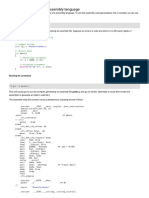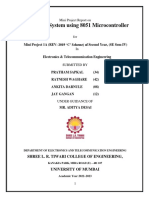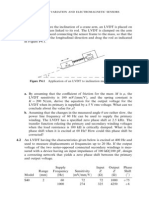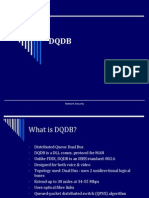0 ratings0% found this document useful (0 votes)
412 viewsBoolean Instructions
Boolean Instructions
Uploaded by
Rohan VaidyaThe 8051 microcontroller contains a Boolean processor for single-bit operations using direct addressing. The carry bit is used as a single-bit accumulator. Boolean instructions referencing the carry bit are assembled as carry-specific instructions. The carry bit also has a mnemonic representation "CY" that can be used with non-carry-specific instructions. An example program uses Boolean instructions to compute the logical AND of two port bits and output the result to another port bit in a loop, with a worst-case delay of 11 CPU cycles.
Copyright:
Attribution Non-Commercial (BY-NC)
Available Formats
Download as DOC, PDF, TXT or read online from Scribd
Boolean Instructions
Boolean Instructions
Uploaded by
Rohan Vaidya0 ratings0% found this document useful (0 votes)
412 views2 pagesThe 8051 microcontroller contains a Boolean processor for single-bit operations using direct addressing. The carry bit is used as a single-bit accumulator. Boolean instructions referencing the carry bit are assembled as carry-specific instructions. The carry bit also has a mnemonic representation "CY" that can be used with non-carry-specific instructions. An example program uses Boolean instructions to compute the logical AND of two port bits and output the result to another port bit in a loop, with a worst-case delay of 11 CPU cycles.
Original Description:
Copyright
© Attribution Non-Commercial (BY-NC)
Available Formats
DOC, PDF, TXT or read online from Scribd
Share this document
Did you find this document useful?
Is this content inappropriate?
The 8051 microcontroller contains a Boolean processor for single-bit operations using direct addressing. The carry bit is used as a single-bit accumulator. Boolean instructions referencing the carry bit are assembled as carry-specific instructions. The carry bit also has a mnemonic representation "CY" that can be used with non-carry-specific instructions. An example program uses Boolean instructions to compute the logical AND of two port bits and output the result to another port bit in a loop, with a worst-case delay of 11 CPU cycles.
Copyright:
Attribution Non-Commercial (BY-NC)
Available Formats
Download as DOC, PDF, TXT or read online from Scribd
Download as doc, pdf, or txt
0 ratings0% found this document useful (0 votes)
412 views2 pagesBoolean Instructions
Boolean Instructions
Uploaded by
Rohan VaidyaThe 8051 microcontroller contains a Boolean processor for single-bit operations using direct addressing. The carry bit is used as a single-bit accumulator. Boolean instructions referencing the carry bit are assembled as carry-specific instructions. The carry bit also has a mnemonic representation "CY" that can be used with non-carry-specific instructions. An example program uses Boolean instructions to compute the logical AND of two port bits and output the result to another port bit in a loop, with a worst-case delay of 11 CPU cycles.
Copyright:
Attribution Non-Commercial (BY-NC)
Available Formats
Download as DOC, PDF, TXT or read online from Scribd
Download as doc, pdf, or txt
You are on page 1of 2
Boolean Instructions
• 8051 contains a complete Boolean processor for single-bit
operations.
• All bit accesses use direct addressing
• Bits may be set or cleared in a single instruction
• Example: SETB P1.7 CLR P1.7
• Carry bit in PSW is used as a single-bit accumulator for Boolean
operations.
• Bit instructions that refer to carry bit as C are assembled as carryspecific
instructions
• Carry also has a mnemonic representation (CY) which can be used
in connection with non-carry-specific instructions.
• Example:
CLR C
CLR CY
Both do the same. First one is 1 byte and the second one is 2-bytes
Boolean Instructions
• Example: Compute the logical AND of the input signals on
bits 0 and 1 of Port 1 and output the result to bit 2 of Port 1.
LOOP: MOV C, P1.0 (1 cycle)
ANL C,P1.1 (2 cycle)
MOV P1.2,C (2 cycle)
SJMP LOOP (2 cycle)
– Worst case delay is when one of the inputs changes right
after the first instruction. The delay will be 11 CPU cycles
(for a 12 MHZ clock, this is 11 us)
There are three versions of JMP instruction: SJMP, LJMP and
AJMP.
• SJMP instruction specifies destination address as a relative
offset. This instruction is 2 bytes and jump distance is limited
to -128 to 127.
• LJMP specifies the destination address as a 16-bit constant.
The destination address can be anywhere in the 64K program
memory space
• AJMP specifies the destination address as an 11-bit constant.
Destination must be within a 2K block of AJMP.
• In all cases, programmer specifies the destination address to
the assembler (using label or a 16-bit constant) and the
assembler puts destination address into correct format.
You might also like
- ESE122Document12 pagesESE122Shahrul Shafiz HaridanNo ratings yet
- Faculty of Computing and Informatics Multimedia UniversityDocument11 pagesFaculty of Computing and Informatics Multimedia UniversityBala GanabathyNo ratings yet
- Interfacing GSM With 8051Document14 pagesInterfacing GSM With 8051Mohammad Ali100% (1)
- Unit5-8051 4th Sem Anna University CseDocument21 pagesUnit5-8051 4th Sem Anna University CseVijayashree VenkatNo ratings yet
- 5 PIC16F887 MicrocontrollerDocument40 pages5 PIC16F887 MicrocontrollerBalakumara Vigneshwaran100% (4)
- 02 Lab02 Fundamentals of 8085 Instruction Sets SampleAnswerZ2Document14 pages02 Lab02 Fundamentals of 8085 Instruction Sets SampleAnswerZ2Najwa LolyPopNo ratings yet
- Questions & Answers On Genetic AlgorithmDocument15 pagesQuestions & Answers On Genetic AlgorithmPragya JainNo ratings yet
- PIC Training ReportDocument34 pagesPIC Training Reportapsingh8105No ratings yet
- Um2788 Getting Started With The Motor Control Sixstep Firmware Example For Stevalptool2v1 StmicroelectronicsDocument29 pagesUm2788 Getting Started With The Motor Control Sixstep Firmware Example For Stevalptool2v1 StmicroelectronicsThanhphimmoi 3sốNo ratings yet
- Programming Examples - I: Chapter - 7Document34 pagesProgramming Examples - I: Chapter - 7vatsalshah24No ratings yet
- Caddo Spectrum Analyzer 80058005TGDocument27 pagesCaddo Spectrum Analyzer 80058005TGilesh22No ratings yet
- INTRODUCTION TO SS7 SIGNALLING - PDocument24 pagesINTRODUCTION TO SS7 SIGNALLING - PNicholas Wilson67% (3)
- Convert C - C++ Code To Assembly LanguageDocument2 pagesConvert C - C++ Code To Assembly LanguageKrishanu Modak0% (1)
- C3 - Instruction Set and Assembly Language Programming (PEMANTAUAN)Document89 pagesC3 - Instruction Set and Assembly Language Programming (PEMANTAUAN)Muhamad Nurhafiz YusoffNo ratings yet
- Memory InterfacingDocument9 pagesMemory InterfacingPiyush chaudhariNo ratings yet
- Microprocessor and Architecture Solution PDFDocument23 pagesMicroprocessor and Architecture Solution PDFKarmaveer Bhaurao Patil CollegeNo ratings yet
- 8051 PRJDocument25 pages8051 PRJParthNo ratings yet
- TIME TABLE MANAGEMENT SYSTEM A Mini Proj PDFDocument7 pagesTIME TABLE MANAGEMENT SYSTEM A Mini Proj PDFSaranya Sa RaNo ratings yet
- Dem 22421 Ut2 QB 070320Document3 pagesDem 22421 Ut2 QB 070320yashpatil0154100% (1)
- Password Protected Circuit Breaker: Audisankara Institute of TechnologyDocument22 pagesPassword Protected Circuit Breaker: Audisankara Institute of TechnologyGokul SriramNo ratings yet
- Function GeneratorDocument16 pagesFunction GeneratorsakibNo ratings yet
- SP LabDocument8 pagesSP LabVibhiNo ratings yet
- Lab MicromanualDocument13 pagesLab MicromanualVamsi Krishna Karthikeya SarmaNo ratings yet
- NTDC It BriefDocument12 pagesNTDC It BriefMuhammad Salman Arshid0% (1)
- Dec40053 Quiz 2 Set A - Jun2019 PDFDocument2 pagesDec40053 Quiz 2 Set A - Jun2019 PDFpuajjjNo ratings yet
- Tripping Sequence Recorder Cum IndicatorDocument7 pagesTripping Sequence Recorder Cum IndicatormahbubunnisaNo ratings yet
- Project Final Review Iip PDFDocument30 pagesProject Final Review Iip PDFKapish mishraNo ratings yet
- IOT Assignment - 2 Q1) Write Short Note On XivelyDocument6 pagesIOT Assignment - 2 Q1) Write Short Note On XivelyPrasad mohiteNo ratings yet
- RTC Based - Automatic College BellDocument53 pagesRTC Based - Automatic College BellPgc VnbNo ratings yet
- Chatgpt CloneDocument36 pagesChatgpt Clonedev510152025No ratings yet
- Unit-I (8086) : Microprocessor and MicrocontrollersDocument22 pagesUnit-I (8086) : Microprocessor and MicrocontrollerskesavantNo ratings yet
- BLDC DriveDocument37 pagesBLDC DriveLasya Ganapathi100% (1)
- FinalDocument26 pagesFinalsnehaNo ratings yet
- Micro Controller and Embedded Systems (Revised)Document2 pagesMicro Controller and Embedded Systems (Revised)Ashok ShahNo ratings yet
- ICW & OCW For 8259Document8 pagesICW & OCW For 8259Aalu YadavNo ratings yet
- Proteus (Design Software) - Wikipedia, The Free EncyclopediaDocument2 pagesProteus (Design Software) - Wikipedia, The Free EncyclopediaswarnaasnlNo ratings yet
- ARM Assignments From NptelDocument13 pagesARM Assignments From NptelBALACHANDRAN ANo ratings yet
- Hardware ProtectionDocument5 pagesHardware ProtectionALi FarHanNo ratings yet
- Adaptive Delta ModulationDocument15 pagesAdaptive Delta ModulationVinita DahiyaNo ratings yet
- 8051 Microcontroller Programming in KeilDocument8 pages8051 Microcontroller Programming in KeilSenthil Kumar SNo ratings yet
- Notice For PresentationDocument6 pagesNotice For Presentationmtarequeali5836No ratings yet
- Bluetooth Controlled Electronic Home AppliancesDocument29 pagesBluetooth Controlled Electronic Home AppliancesKaos Polos Nakira100% (5)
- Module - 1: Salient Features of The Cortex-M3Document29 pagesModule - 1: Salient Features of The Cortex-M3Dr Ravi Kumar A.VNo ratings yet
- Lab 5 Data Transfer: Y. Use The Simulator To Change The X Value and Single-Step Through TheDocument3 pagesLab 5 Data Transfer: Y. Use The Simulator To Change The X Value and Single-Step Through Thesabi1234No ratings yet
- Lecture Notes: Microprocessors and MicrocontrollersDocument217 pagesLecture Notes: Microprocessors and MicrocontrollersNikhila NikkiNo ratings yet
- Assignment 7 SolutionDocument8 pagesAssignment 7 Solutionsoumya sekhar mahanti100% (1)
- ProjectDocument22 pagesProjectSandeep SharmaNo ratings yet
- 17ec563 M01Document28 pages17ec563 M01mohamed036100% (1)
- Embedded System PracsDocument7 pagesEmbedded System PracssayajiNo ratings yet
- MPMC I Mid & Quiz Question Paper FormatDocument6 pagesMPMC I Mid & Quiz Question Paper FormatBobby SatyaNo ratings yet
- Opamp PPT For Engineering First Year StudentsDocument33 pagesOpamp PPT For Engineering First Year Studentsdarshankumar999No ratings yet
- Baitap LVDTDocument2 pagesBaitap LVDTBùi Công Huy Cường100% (1)
- LPC2148 User GuideDocument58 pagesLPC2148 User GuideRishabVenkataramanNo ratings yet
- Tutorial 3-4: Formula Used AnswerDocument5 pagesTutorial 3-4: Formula Used Answerdareghost ytNo ratings yet
- Counters in Digital ElectronicsDocument3 pagesCounters in Digital Electronicsdhirajkumar_1No ratings yet
- Experiment No. 2 Control System Simulation Using MATLAB and SIMULINKDocument11 pagesExperiment No. 2 Control System Simulation Using MATLAB and SIMULINKSom Pratap SinghNo ratings yet
- DQDBDocument10 pagesDQDBJetesh DevgunNo ratings yet
- 5 Instruction SetDocument41 pages5 Instruction SetElectroalumni NietNo ratings yet
- Instruction Groups: The 8051 Has 255 Instructions - Every 8-Bit Opcode From 00 To FF Is Used Except For A5.Document30 pagesInstruction Groups: The 8051 Has 255 Instructions - Every 8-Bit Opcode From 00 To FF Is Used Except For A5.VLC350ZNo ratings yet
- Arithmetic Logic Unit (Alu) Design Using Reconfigurable Cmos LogicDocument18 pagesArithmetic Logic Unit (Alu) Design Using Reconfigurable Cmos Logicrasheed72No ratings yet
- 8085 Instruction Addressing Modes ImppDocument87 pages8085 Instruction Addressing Modes ImppRohan VaidyaNo ratings yet
- Introduction To Protected ModeDocument1 pageIntroduction To Protected ModeRohan VaidyaNo ratings yet
- Gray To Binary ConversionDocument2 pagesGray To Binary ConversionRohan VaidyaNo ratings yet
- Timing Diagram Mvi A, 32Document2 pagesTiming Diagram Mvi A, 32Rohan Vaidya60% (15)































































